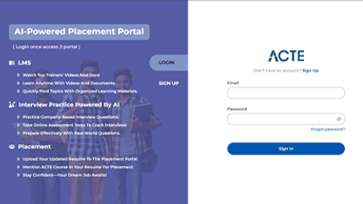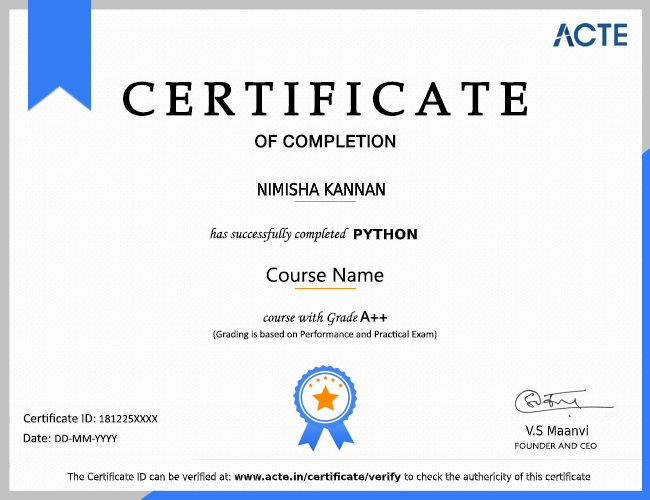ACTE offers Teradata online training course.Teradata is a fully scalable relational database management system produced by Teradata Corp. It is widely used to manage large data warehousing operations.The Teradata database system is based on off-the-shelf symmetric multiprocessing technology combined with communication networking, connecting symmetric multiprocessing systems to form large parallel processing systems.Start Learning with us ACTE Teradata Classroom and Online Training Course.
Teradata is massively parallel open processing system for developing large-scale data warehousing applications. ... It is a vendor of analytic data platforms, application, and other related services. The firm develops a product to consolidate data from the various source and make the data available for analysis.
- Teradata is a data warehouse product. It is meant for Analytical processing to data or an OLAP database.
- It has capability to take data from various sources and transform it into the form which is easy to analyse. It is known as ETL process (Extract, Transform and Load)
- The amount of data it can handle is way more than traditional RDBMS systems withiut affecting performance.
Teradata is a fully scalable relational database management system produced by Teradata Corp. It is widely used to manage large data warehousing operations
With linear scalability (Software can scale linearly with hardware), unconditional parallelism, multi-faceted parallelism, intelligent data distribution, parallel-aware optimizer makes Teradata is capable of handling large data and complex queries.
We are happy and proud to say that we have strong relationship with over 700+ small, mid-sized and MNCs. Many of these companies have openings for Teradata . Moreover, we have a very active placement cell that provides 100% placement assistance to our students. The cell also contributes by training students in mock interviews and discussions even after the course completion.
The below mentioned two categories play the most important role in the technology-based career paths.
- Software Development Engineers: Software Engineering is one of the important job categories based on the technology-based learning approach and studies. They deal with the different aspects of software analysis and approaches and related development studies.
- Software QA Professional: While considering the Software QA professions, it mainly consists of two approaches viz. Manual and Automation.
- It allows us to write SQL statements along with BTEQ commands. We can use BTEQ for importing,exporting and reporting purposes.
- The commands start with a (.) dot and can be terminated by using (;), it is not mandatory to use (;). SQL statements doesnt start with a dot , but (;) is compulsary to terminate the SQL statement.
- BTEQ will assume any thing written with out a dot as a SQL statement and requires a (;) to terminate it.
- BTEQ is a variant of the core set of ANSI SQL, with proprietary 'extensions' that are specific to Teradata databases only.
- Similar to PL/SQL for Oracle, or T-SQL for Microsoft SQL Server, BTEQ includes the ability to perform database-vendor-specific instructions that are particular to Teradata .
Yes, you can and you should. The internet landscape is full of training videos, A plethora of awesome websites are available that one can leverage to enhance their Teradata skills. The best part about learning Teradata is the availability of Teradata manuals that are released by Teradata Corp
Our courseware is designed to give a hands-on approach to the students in Teradata . The course is made up of theoretical classes that teach the basics of each module followed by high-intensity practical sessions reflecting the current challenges and needs of the industry that will demand the students’ time and commitment.
We have a high price pressure on rates, leading to a downward trend regarding income and quality. In Europe, the situation is that Teradata searches people from countries with cheaper rates and sells them to the more expensive ones. As soon as prices go up, new countries are explored being even cheaper. This trend is speeding up drastically since a few years.
Teradata is a popular Relational Database Management System (RDBMS) suitable for large data warehousing applications. It is capable of handling large volumes of data and is highly scalable. This tutorial provides a good understanding of Teradata Architecture, various SQL commands, Indexing concepts and Utilities to import/export data.
Teradata transforms how businesses work and people live through the power of data. Teradata leverages all of the data, all of the time, so you can analyze anything, deploy anywhere, and deliver analytics that matter most to your business. And we do it on-premises, in the cloud, or anywhere in between
Teradata
Teradata is one of the most popular Relational Database Management Systems, which is built on massively parallel services to develop large-scale data warehouse applications.It supports multiple server platforms like Unix/Linux/Windows and is capable of providing support to a number of client environments at a time.It is basically developed by Teradata Corporation, which is a provider of database and analytics related products and services.
Why go for Teradata?
- When your company is running high processing, large volume data warehouse, Teradata is the best option. It is designed to handle massive amounts of data efficiently by processing them parallelly to the tiniest transactions within.
- It performs powerful OLAP(Online Analytical Programming) functions to perform complex analytical functions on data, along with a limitless report review and data discovery.
- Incorporate Teradata into your systems, if you are looking for high-performance and linear scalability of the database, which is not very likely with Oracle or other DBMS data structures.
Features of Teradata
There are a number of distinguishing features of Teradata that add value to the Teradata RDM system. These features are listed below:
1) Linear Scalability
Teradata offers high, linear scalability which allows a large volume of data to be handled efficiently at a time, by adding nodes for increased data chunks. It can be scaled up to as high as 2048 nodes, which enhances the performance of the system greatly.
2) Unlimited Parallelism
The architecture of Teradata is based on massively parallel processors(MPP), which divides large volumes of data into smaller processes to process them parallelly. This ensures the speedy execution of complex tasks.
3) Mature Optimizer
Teradata Optimizer is one of the most advanced optimizers available, which can handle up to 64 joins in a single query.
4) Shared Nothing Architecture of Teradata
The Teradata nodes, Access Module Processors (AMPs) and disks work independently. These resources are not shared, hence providing the best value for a given task. The 100% availability of every resource enhances efficiency by decreasing the process execution time.
5) Connectivity
The parallel system of Teradata can connect to channel-attached systems like network-attached systems or mainframes
6) Low TCO
The Teradata system offers a low total cost of ownership, as it is easy to set up maintain and administer the arrangement.
7) SQL
Teradata systems allow implementation of SQL to interact with the data in the database easily. It also provides its own extension.
8) Load & Unload utilities
Teradata provides load & unload utilities to move data in and out of the Teradata system.
9) Automatic Distribution
Teradata can easily distribute the data to its disks without any external intervention.
10) Robust Utilities
There are many robust utilities provided by Teradata to handle the data in and out of the Teradata systems. FastLoad, MultiLoad, FastExport, and TPT are few of them which helps in import and export of data to and from the systems.
Teradata SQL
- Teradata allows SQL queries to perform required functions on the Teradata database. The basic structure of SQL queries along with some functions and other details are discussed below.
- Database - It is a collection of logically related data stored in tables for easy analysis and access.
- Tables - These are the basic units of any DBMS set where data is stored. A table is made of rows and columns.
- Primary Key - It is the unique key that holds distinct value to identify a specific row. No duplicates and no null values are accepted for this key. It is a mandatory field for any table in RDBMS.
- Foreign Key - Foreign key in a child table is the primary key in the parent table, which is used to build relations. It accepts both null values and duplicate values. It is not compulsory for a table.
Teradata Developer
- Developed design documentation and implementation proposal for extraction of data from W data warehouse.
- Developed modules to extract, process & transfer the customer data using Teradata utilities.
- Created Fast Export scripts for extracting and formatting customer data from data warehouse in a mainframe file.
- Created FTP Id to set up transmission path between mainframe and UNIX machine.
- Developed an environment to receive an external source file for the data that were missing in W tables.
- Performed the value added processing (VAPS) on the Customer data generated for user.
- Modified the file transmission protocol used in Bank which in turn provided an enormous amount of savings to the bank.
- Performed discharge of stale components from mainframe in turn reduced the maintenance cost for bank.































